Sarah Sundin's Blog, page 207
September 19, 2018
Today in World War II History—Sept. 19, 1943
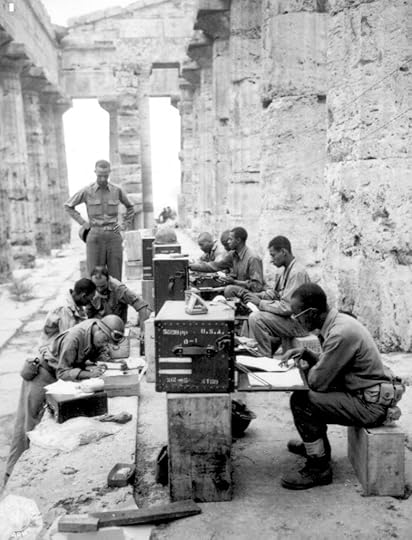
US soldiers in makeshift Fifth Army office in ancient Temple of Neptune in Paestum, Italy, 22 September 1943 (US National Archives)
75 Years Ago—Sept. 19, 1943: In Italy, Allies secure Salerno plain.
Australians open offensive in Ramu Valley, New Guinea and take Kaiapit, but the Japanese counterattack in force.
Decca Records signs deal with the striking musicians’ union and becomes the first studio to record in a year.
September 18, 2018
Hospitalization in World War II – Mobile and Fixed Hospitals
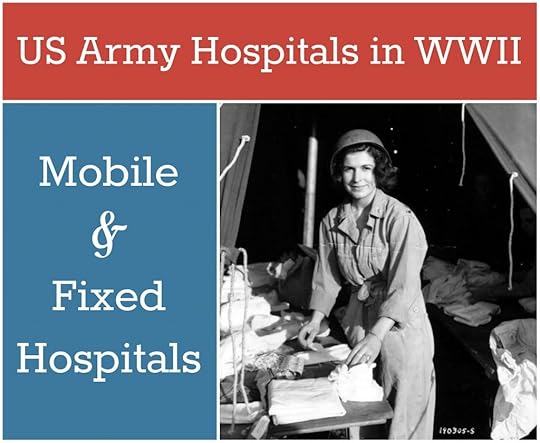
Photo: US Army nurse preparing dressings, 15 June 1944, 13th Field Hospital, St.-Laurent-sur-Mer, Normandy (US National Archives)
Hutch crossed his arms over his soggy mackinaw and gave Bergie half a smile. “You said you’d take over. Ever pitch a tent before?”
“In Boy Scouts.” The surgeon raised a three-finger salute. “On my honor–“
“A big old Army ward tent?”
“Nope. But I’m willing to get dirty. What’s mud compared to the blood and guts I usually swim in?”
Hutch turned to Sergeant Paskun. “I’ll put the captain on my team and mess up his pretty officer’s manicure.”
“Heavens to Betsy!” Bergie said in a falsetto, inspecting his fingernails. “I just had them done.” (On Distant Shores, p. 150)
In my novel On Distant Shores, the hero serves as a pharmacist in an evacuation hospital and the heroine serves as a flight nurse. I’m running a series on hospitalization in World War II. Last week I discussed the chain of evacuation, today I’ll discuss mobile and fixed hospitals in more detail, and next week I’ll cover evacuation of the wounded.
Mobile Hospitals
Field hospitals (400 beds) and evacuation hospitals (400 or 750 beds) arrived within a few days of an invasion and followed the army, staying about thirty miles behind the front. They were close enough to treat patients quickly and send them back to the front quickly as well.
These hospitals relied on mobility. They usually used canvas tents, but also used schools, barracks, hospital buildings, hotels, Mediterranean villas, and even an Italian stadium. A few days before a move, the hospital stopped admitting patients and evacuated their current patients to other hospitals. They packed their equipment and personnel into trucks, advanced to the next location, set up, and were ready to admit patients within hours.
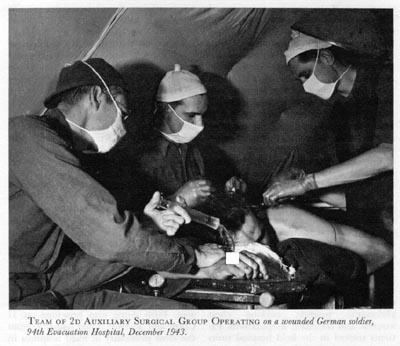
Surgeons at 94th Evacuation Hospital, Italy, December 1943 (US Army Medical Dept.)
When ambulances arrived, triage officers sent patients to pre-op, medical, shock, or evacuation wards as needed. Surgical teams worked twelve hours on, then twelve hours off.
In the European Theater (England, France, Belgium, Germany), the field hospitals stayed closer to the front, with the evacuation hospitals farther to the rear. In the Mediterranean Theater (North Africa, Sicily, Italy, southern France), field hospitals and evacuation hospitals were used interchangeably. Both theaters practiced “leapfrogging” as the front advanced—hospital A would pass hospital B, then hospital B would pass hospital A. This reduced the frequency of moves.
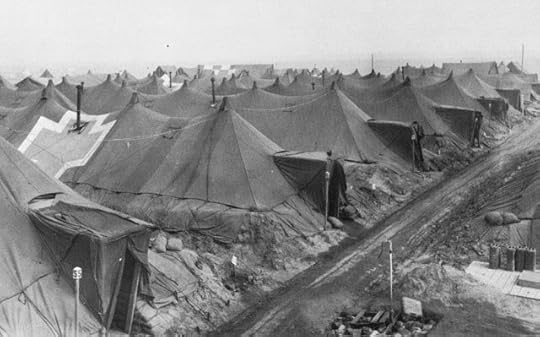
US evacuation hospital tents on the Anzio beachhead, Italy, spring 1944, revetted for protection from bombs and shells (US Army Medical Dept.)
Fixed Hospitals
The station hospitals (250, 500, or 750 beds), general hospitals (1000 beds), and convalescent hospitals (2000 or 3000 beds) were set up far from the front to keep patients safe from danger, but also to keep them in the theater, which made it easier to return the soldiers to duty. In England before D-day, field and evacuation hospitals waiting for the Normandy invasion functioned as station hospitals to care for patients.
In each theater of operations, fixed hospitals operated in what was called the “Communications Zone.” In the European Theater, the COMZ was originally in England, then as the Allies approached the German border, the COMZ extended to include Normandy and Belgium. In the Mediterranean Theater, Morocco served as the first COMZ, then Algeria. When the Allies invaded Sicily and Italy, North Africa was the COMZ, and as the front advanced, the COMZ was established in the Naples area of southern Italy. In the Pacific, fixed hospitals were first established in Hawaii and Australia, then followed into secured regions.
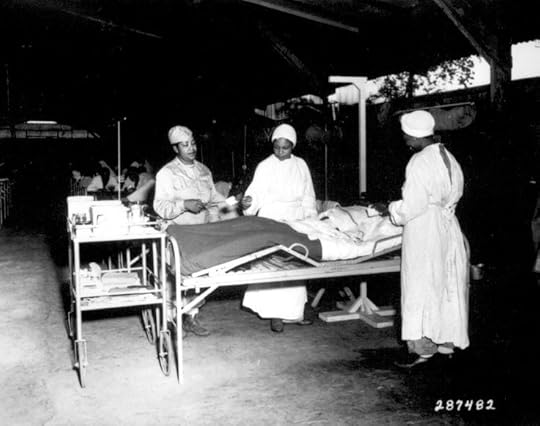
African-American US Army nurses Lt Prudence Burns, Lt Elcena Townscent, and a 3rd nurse treating Sgt Lawrence McKreever 268th Station Hospital, Milne Bay, New Guinea, 22 Jun 1944 (US National Archives)
Fixed hospitals moved less often and occupied more permanent facilities. American units used some standing hospitals in host or occupied countries, but many were a collection of tents or Nissen huts, 20-ft by 40-ft corrugated tin semi-cylinders. In England, Nissen-hut hospital complexes were often placed on estate grounds, and had concrete floors, flush toilets, clean water, and were heated by coal-burning stoves. In the Mediterranean and Pacific, facilities were more primitive but improved over time. In these theaters, mosquito netting was draped over the beds to prevent transmission of malaria.
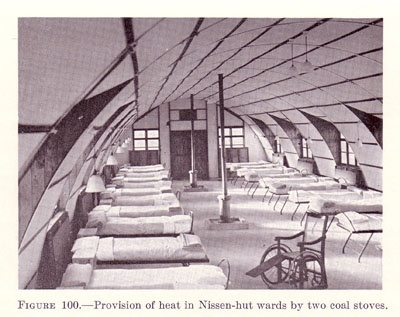
Nissen-hut hospital in England. Note coal stoves in center (US Army Medical Dept.)
Fixed hospitals in the Zone of the Interior (continental United States) enjoyed the benefits of modern buildings and facilities. However, shortages of medication, equipment, and personnel were always a problem.
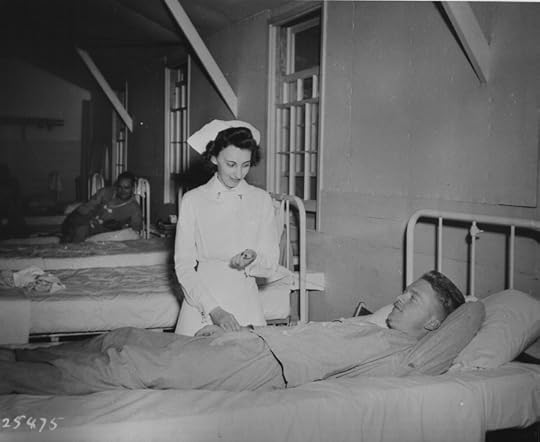
Army nurse attending patient, Camp Forrest, Tullahoma, TN, 22 Sept. 1941 (US Army Medical Dept.)
Resources
Cosmas, Graham A. & Cowdrey, Albert E. The Medical Department: Medical Service in the European Theater of Operations. Washington, D.C.: United States Army Center of Medical History, 1992.
Wiltse, Charles M. The Medical Department: Medical Services in the Mediterranean and Minor Theaters. Washington, DC: Office of the Chief of Military History, Department of the Army, 1965.
Condon-Rall, MaryEllen & Cowdrey, Albert E. The Medical Department: Medical Service in the War Against Japan. Washington, D.C.: United States Army Center of Medical History, 1998.
Links, Mae Mills & Coleman, Hubert A. Medical Support of the Army Air Forces in World War II. Washington, D.C.: Office of the Surgeon General, USAF, 1955.
Smith, Clarence McKittrick. The Medical Department: Hospitalization and Evacuation, Zone of the Interior. Washington, DC: Center of Military History, United States Army, 1989.
Today in World War II History—Sept. 18, 1943

Map of the Gilbert and Marshall Islands, Central Pacific (US Army Center of Military History)
75 Years Ago—Sept. 18, 1943: US opens Central Pacific offensive as US Seventh Air Force B-24 bombers and Navy Task Force 15 carrier aircraft begin bombing Tarawa, Makin, and Apemama in the Gilbert Islands.
Premiere of weekly radio show I Sustain the Wings on CBS with Capt. Glenn Miller and the Army Air Force Band.
September 17, 2018
Today in World War II History—Sept. 17, 1943
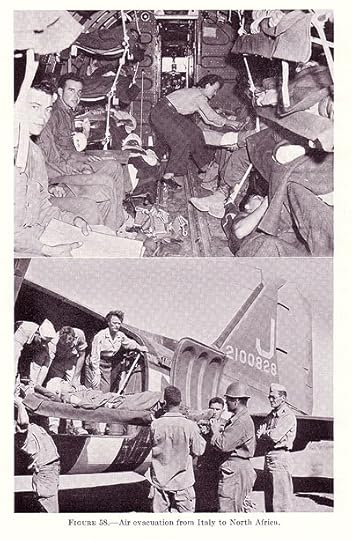
US medical air evacuation from Italy to North Africa, 1943 (US Army Medical Department photo)
75 Years Ago—Sept. 17, 1943: Germans begin retreat from Salerno plain in Italy.
US 802nd Medical Air Evacuation Transport Squadron begins air evacuation from Salerno, Italy.
Soviets take Bryansk, Russia.
September 16, 2018
Today in World War II History—Sept. 16, 1943
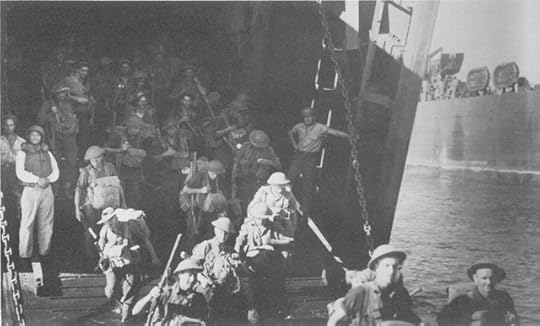
Australian troops debarking from LST landing ships for the occupation of Lae, New Guinea, September 1943 (US Army Center of Military History)
75 Years Ago—Sept. 16, 1943: Australians take Lae on New Guinea.
Soviets take Novgorod and Novorossisk, Russia.
Danish Freedom Council (Frihedsrådet) established to organize resistance groups, with British SOE support.
September 15, 2018
Today in World War II History—Sept. 15, 1943
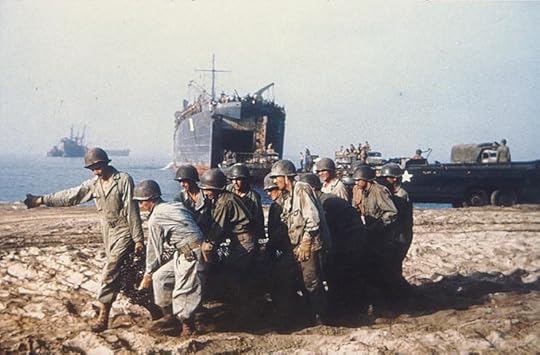
With USS LST-1 in the background, US Army Engineers haul a roll of wire mesh to make a beach roadway, Salerno, Italy, September 1943 (US National Archives)
75 Years Ago—Sept. 15, 1943: US and British forces repulse German attacks at Salerno, Italy and secure the beachhead.
Germans announce death penalty for Italians caught with firearms.
September 14, 2018
Today in World War II History—Sept. 14, 1943

US guards at the Temple of Neptune, Paestum, Italy, which served as US Fifth Army HQ after the landings at Salerno, Italy, September 1943 (US National Archives)
75 Years Ago—Sept. 14, 1943: At Salerno, Italy, US repels German counterattack.
Meanwhile, British Eighth Army progresses to control “heel” and “toe” of Italy.
September 13, 2018
Today in World War II History—Sept. 13, 1943
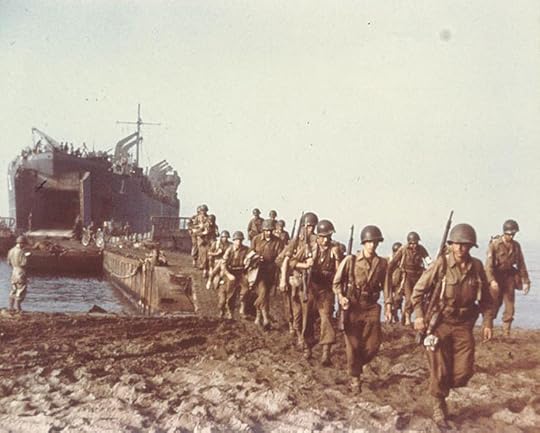
USS LST-1 landing US troops on a beach near Salerno, Italy, September 1943 (US National Archives)
75 Years Ago—Sept. 13, 1943: At Salerno, Italy, Germans counterattack down the Sele River and drive to within 3 miles of the beach, and paratroopers of the US 82nd Airborne are dropped behind US lines near Paestum as reinforcements.
British hospital ship Newfoundland is sunk by the Luftwaffe off Salerno, Italy; 23 killed, including all physicians and 6 nurses.
September 12, 2018
Today in World War II History—Sept. 12, 1943
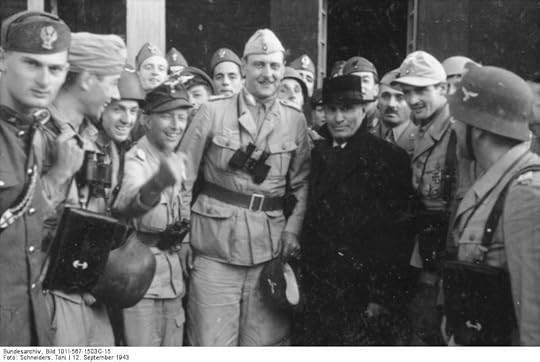
Otto Skorzeny, Harald Mors, and Benito Mussolini in front of Hotel Campo Imperatore, Gran Sasso, Italy, 12 Sept 1943 (German Federal Archive: Bild 101I-567-1503C-15)
75 Years Ago—Sept. 12, 1943: German SS detachment in gliders rescues Mussolini from Gran Sasso, where he was imprisoned by the Italian government.
In New Guinea, Australians take Salamaua and its airfield.
US War Ration Book Three becomes active.
September 11, 2018
Hospitalization in World War II – Chain of Evacuation
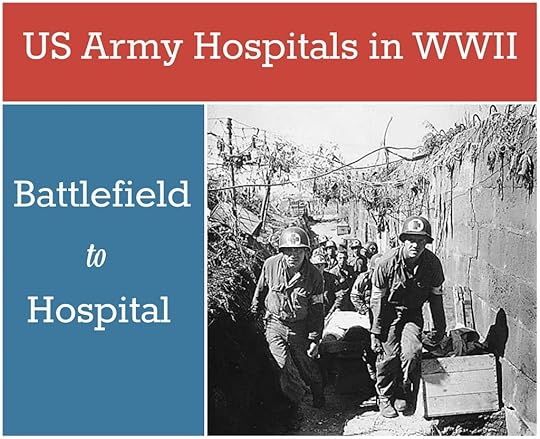
Photo: US Army medics removing a casualty from the battlefield to an aid station in an air shelter, near Brest, France, 28 Aug 1944 (US National Archives)
Planes thundered overhead, artillery rumbled in the distance, and cries of wounded soldiers pierced Georgie’s ears.
“Coming through.” Two medics rushed past with a litter. A man writhed on top, a shock of red on his gray-green field jacket. Another medic assisted a soldier who clutched his twisted, bloodstained arm to his chest.
Georgie took a deep breath. Compared to the ravages of battle, her concerns were nitpicky. (On Distant Shores, p. 118)
In my novel On Distant Shores, the hero serves as a pharmacist in a US Army evacuation hospital and the heroine serves as a flight nurse. I’m running a series on Army hospitalization in World War II. Today I’ll discuss the chain of evacuation, next week I’ll discuss mobile and fixed hospitals in more detail, and the following week I’ll cover evacuation of the wounded.
The Chain of Evacuation
Wartime medical treatment occurred on muddy battlefields under fire, in tent hospitals only miles from the front, and in sterile stateside hospitals.
A complex chain moved patients to where they could best be treated. At all points along this chain, decisions were made regarding when to treat, when to return to duty, and when to evacuate further to the rear.
Organic Medical Units
These units were attached to combat units and followed them into battle.
Battlefield: Medics performed first aid and moved the wounded to the aid station, often under fire.
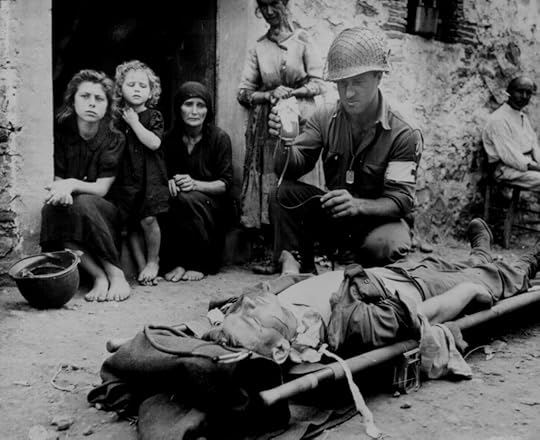
US Army PFC Harvey White administering plasma to wounded Private Roy Humphrey, Sant’Agata, Sicily
Italy, 9 Aug 1943 (US National Archives)
Battalion aid station: About one mile from front. Physicians and medics adjusted splints and dressings, and administered plasma and morphine. Soldiers also reported to the aid station for treatment of minor illnesses or mild combat fatigue.
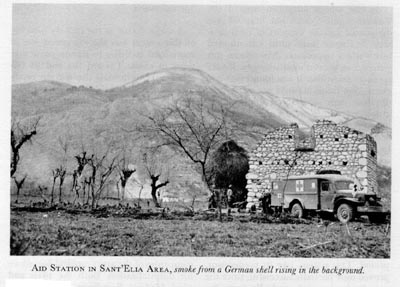
US Army forward aid station in Sant’Elia, Italy, 1943 (US Army Medical Dept)
Collecting station: About two miles from the front, near the regiment command post. Further adjustment of splints and dressings, administration of plasma, and treatment of shock.
Clearing station: About four to ten miles from the front. Here they treated shock and minor wounds, and grouped patients in ambulance loads for transport to field hospitals.
Mobile Hospitals
These hospitals were assigned to a theater of operations and could be packed and moved quickly to follow the battle lines. They were complete hospitals with nursing care, surgical and medical wards, X-ray, laboratory, and pharmacy.
Field Hospitals: Within thirty miles of clearing station. Ideally, the wounded arrived within one hour of injury. Surgery was performed for the most severe cases.
Evacuation Hospitals: Treated illnesses and less urgent surgical cases. Patients could be reconditioned here to return to the front.
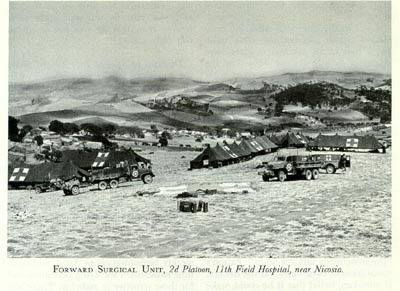
Forward surgical unit, US 11th Field Hospital near Nicosia, Sicily, 1943 (US Army Medical Dept)
Fixed Hospitals
These hospitals were set up a safe distance from the front, either in the theater of operations or stateside, and they tended to remain in one location for longer periods of time.
Station Hospitals: Usually attached to a military base, designed to treat illnesses and injuries among personnel stationed at that base.
General Hospitals: Large facilities where patients received long-term treatment, sometimes grouped in large complexes. Some of the general hospitals were specialized for certain types of wounds or illnesses, such as for craniocerebral, spine, eye, chest, or neuropsychiatric care.
Convalescent Hospitals: Designed for rehabilitation of the severely wounded soldier who would receive a medical discharge. This type of hospital was a World War II innovation.
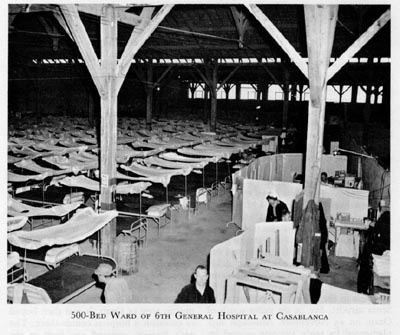
500-bed ward of US 6th General Hospital, Casablanca, French Morocco, 1943 (US Army Medical Dept)
Resources
Cosmas, Graham A. & Cowdrey, Albert E. The Medical Department: Medical Service in the European Theater of Operations. Washington, D.C.: United States Army Center of Medical History, 1992.
Wiltse, Charles M. The Medical Department: Medical Services in the Mediterranean and Minor Theaters. Washington, DC: Office of the Chief of Military History, Department of the Army, 1965.
Condon-Rall, MaryEllen & Cowdrey, Albert E. The Medical Department: Medical Service in the War Against Japan. Washington, D.C.: United States Army Center of Medical History, 1998.
Links, Mae Mills & Coleman, Hubert A. Medical Support of the Army Air Forces in World War II. Washington, D.C.: Office of the Surgeon General, USAF, 1955.



